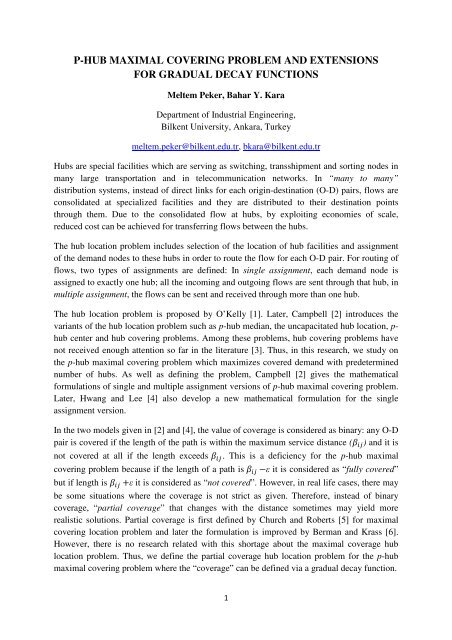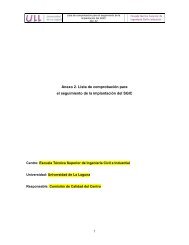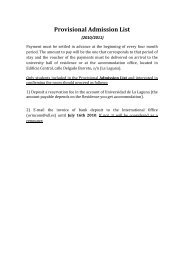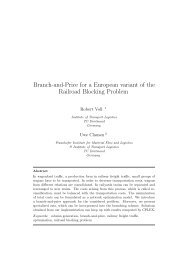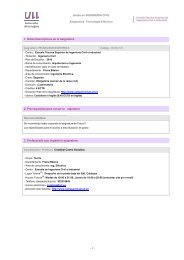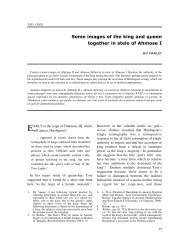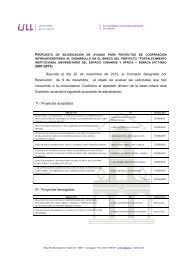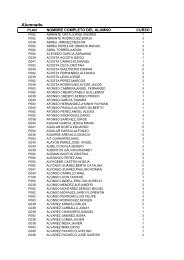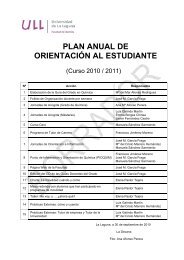Meltem Peker
Meltem Peker
Meltem Peker
Create successful ePaper yourself
Turn your PDF publications into a flip-book with our unique Google optimized e-Paper software.
P-HUB MAXIMAL COVERING PROBLEM AND EXTENSIONSFOR GRADUAL DECAY FUNCTIONS<strong>Meltem</strong> <strong>Peker</strong>, Bahar Y. KaraDepartment of Industrial Engineering,Bilkent University, Ankara, Turkeymeltem.peker@bilkent.edu.tr, bkara@bilkent.edu.trHubs are special facilities which are serving as switching, transshipment and sorting nodes inmany large transportation and in telecommunication networks. In “many to many”distribution systems, instead of direct links for each origin-destination (O-D) pairs, flows areconsolidated at specialized facilities and they are distributed to their destination pointsthrough them. Due to the consolidated flow at hubs, by exploiting economies of scale,reduced cost can be achieved for transferring flows between the hubs.The hub location problem includes selection of the location of hub facilities and assignmentof the demand nodes to these hubs in order to route the flow for each O-D pair. For routing offlows, two types of assignments are defined: In single assignment, each demand node isassigned to exactly one hub; all the incoming and outgoing flows are sent through that hub, inmultiple assignment, the flows can be sent and received through more than one hub.The hub location problem is proposed by O’Kelly [1]. Later, Campbell [2] introduces thevariants of the hub location problem such as p-hub median, the uncapacitated hub location, p-hub center and hub covering problems. Among these problems, hub covering problems havenot received enough attention so far in the literature [3]. Thus, in this research, we study onthe p-hub maximal covering problem which maximizes covered demand with predeterminednumber of hubs. As well as defining the problem, Campbell [2] gives the mathematicalformulations of single and multiple assignment versions of p-hub maximal covering problem.Later, Hwang and Lee [4] also develop a new mathematical formulation for the singleassignment version.In the two models given in [2] and [4], the value of coverage is considered as binary: any O-Dpair is covered if the length of the path is within the maximum service distance ( ) and it isnot covered at all if the length exceeds . This is a deficiency for the p-hub maximalcovering problem because if the length of a path is ε it is considered as “fully covered”but if length is ε it is considered as “not covered”. However, in real life cases, there maybe some situations where the coverage is not strict as given. Therefore, instead of binarycoverage, “partial coverage” that changes with the distance sometimes may yield morerealistic solutions. Partial coverage is first defined by Church and Roberts [5] for maximalcovering location problem and later the formulation is improved by Berman and Krass [6].However, there is no research related with this shortage about the maximal coverage hublocation problem. Thus, we define the partial coverage hub location problem for the p-hubmaximal covering problem where the “coverage” can be defined via a gradual decay function.1
We propose a new mathematical formulation for the single assignment p-hub maximalcovering problem which can also be used for the partial decay functions. The proposedformulation for single allocation has O (n 2 ) binary variables and requires O (n 3 ) constraintswhereas the models proposed in [2] and [4] have O (n 4 ) binary variables and O (n 4 )constraints.Mathematical Analysis and Computational ResultsThe p-hub maximal covering problem for single assignment case can be formally stated asfollows. Let N be the set of points for demand nodes and potential hub locations. is thedistance from origin i to destination j, ∀ , ∈ . For every O-D pair, each path length from ito j is calculated by preprocessing with the equation , where α isthe economies of scale parameter to be used to discount the cost for transferring flow betweenhubs, where 0 ≤ α ≤ 1. Also, there exists a maximum allowable service distance for each O-Dpair denoted by . Then we define as a binary parameter to decide whether i-j pair iscovered by using hubs k and m or not: 1 0 ∀, , , ∈ 1The developed formulation can also be applicable to the case where coverage is defined via agradual decay function. Instead of (1), the following can be used for the partial coverage:1 0 ∀, , , ∈ 2where f is any nonincreasing decay function and is the upper bound for the partialcoverage. Although the applicability of the formulations to the partial coverage is not definedin [2] and [4], those formulations can also be applied to the new problem with (2) fornonincreasing decay functions.Computational experiments are performed to show the effectiveness of the new formulation.For preliminary analysis, we used Civil Aeronautics Board (CAB) data set given in [1]. SinceCAB data set does not include any maximum service distance ( ), we used optimalobjective function values (β) for the p-hub center problem given in [7]. For the maximumservice distance, we used ∗ 0.75 ∀ , . Then can be defined as: 1 ∗ 0.750 The results show that, [4], the most up to date formulation in the literature performs worsethan the basic formulation proposed by Campbell [2]. To compare the results, we set a timelimit of two hours and obtain the result using CPLEX. Based on 8 cases, on the average thegap between the best integer solution and the best bound is 927% for [4] and 9.26% for [2].Therefore, both of the models fail to prove the optimality within two hours. However, withthe proposed formulation, optimum results are achieved within 100 seconds.2
For the partial coverage of the p-hub maximal covering problem, we use a step function forCAB data set for gradual decay function. Our proposed formulation again performs betterthan the other formulations. Even though the solution times are higher than the CPU of thebinary coverage, with new developed formulation the problem is still solved within 6 minutes.Models given in [4] and [2] still find suboptimal results and on the average the gap is1134.25% and 7.44% respectively.The proposed model will also be tested on large data sets such as TR Data [8]. We expect thatthe proposed formulation with O (n 2 ) structure will again perform significantly better than theones in the literature. We also will analyze and discuss the multi allocation version of theproblem.References[1] O’Kelly, M.E (1987), “A quadratic integer program for the location of interacting hubfacilities”, European Journal of Operation Research 302, 393-404.[2] Campbell, J. F. (1994), “Integer programming formulations of discrete hub locationproblems”, European Journal of Operational Research 72, 387–405.[3] Alumur, S. and Kara, B.Y. (2008), “Network hub location problems: The state of the art”,European Journal of Operational Research 190, 1–21.[4] Hwang, Y. H. And Lee, Y.H. (2012), “Uncapacitated single allocation p-hub maximalcovering problem”, Computers and Industrial Engineering, 63, 382-389.[5] Church, R.L. and Roberts, K. L. (1983), “Generalized Coverage Models and PublicFacility Location”, Papers of the Regional Science Association, 53, 117-135[6] Berman, O. and Krass, D. (2002), “The generalized covering location problem”,Computers and Operations Research, 29, 563-581.[7] Kara, B.Y. and Tansel, B.C. (2003), “The single assignment hub covering problem:Models and linearizations”, Journal of the Operational Research Society, 54, 59-64.[8] Tan, P. and Kara, B.Y. (2007) “A hub covering model for cargo delivery systems”,Networks, 49 (1), 28-39.3


